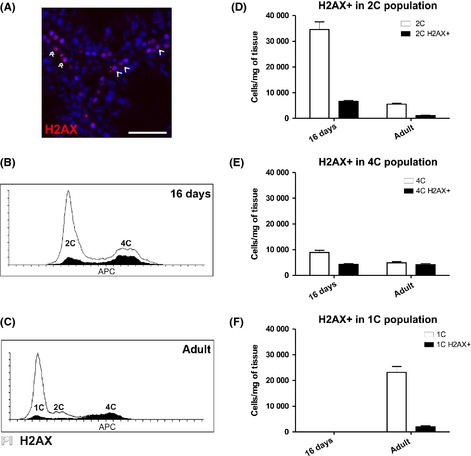Figure 5.

γH2AX‐S139 can be used as a marker for specific germ cell subpopulations in the flow cytometry assay. (A) Immunofluorescence on paraformaldehyde‐fixed paraffin‐embedded 16dpp and adult rat testis using anti‐γH2AX‐S139 (red) and DAPI as a nuclear counter stain. Double arrowhead = 4C cells with γH2AX‐positive sex body. Open arrowhead = γH2AX ‐positive spermatogonia. Scale bar represents 50 μm. (B–D) In the adult testis, γH2AX‐S139‐positive cell are detected in the subpopulations expected based on literature: Fraction of 1C and 2C cells and the majority of 4C cells. No γH2AX‐S139‐positive cells are observed at 16 dpp in the 1C cells population. (B) Representative histogram of 16 dpp rat testis stained with γH2AX‐S139‐antibody (black) and DNA stain (FxCycle, white). (C) Representative histogram of adult rat testis stained with γH2AX‐S139‐antibody (black) and DNA stain (FxCycle, white). (D) γH2AX‐S139‐positive cells (black) clustering within the 2C cell population (white) in 16‐day‐old and adult rat testis. N = 5/group. (E) γH2AX‐S139‐positive cells (black) clustering within the 4C cell population (white) in 16‐day‐old and adult rat testis. N = 5/group. (F) γH2AX‐S139‐positive cells (black) clustering within the 1C cell population (white) in 16‐day‐old and adult rat testis. N = 5/group.
